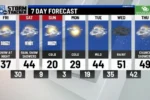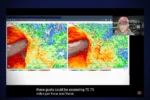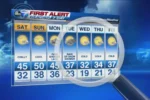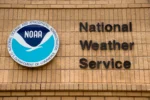Winter is here, and with it comes the excitement of snow! But this week, the National Weather Service (NWS) has issued important warnings for six states across the U.S., predicting up to 2 feet of snow in some areas! This can be a winter wonderland for some, but it also means we need to be careful. Freezing temperatures can be dangerous, especially for little ones and older folks. Let’s explore what these winter storms are all about, how they can affect our daily lives, and what you should know to stay safe during this snowy season!
| State | Warnings/Advisories | Forecasted Snowfall | Travel Impact |
|---|---|---|---|
| Washington | Winter Storm Warning | 1 to 2 feet above 3,000 feet | Very challenging travel conditions expected. |
| Wyoming | Winter Storm Warning | 7 to 14 inches; 18 to 28 inches in higher elevations | Difficult travel due to falling and blowing snow. |
| Montana | Winter Weather Advisory | Moderate snow causing inconveniences | Hazardous travel on affected routes. |
| Michigan | Winter Weather Advisory | Light freezing rain and snow expected | Slippery roads likely. |
| Idaho | Winter Weather Advisory | Two to four inches of snow expected | Some travel inconvenience. |
| Alaska | Winter Weather Advisory | Freezing rain and light snow possible | Watch for slippery conditions. |
Understanding Winter Weather Warnings
Winter weather warnings are issued by the National Weather Service (NWS) to alert people about dangerous weather conditions. These warnings indicate that significant snowfall, ice, or other hazardous weather is expected. For example, in certain states, warnings have been issued where up to 2 feet of snow may fall. This means that anyone in these areas should prepare for difficult travel conditions and possible power outages.
When a winter storm warning is in effect, it’s essential to take precautions. This can include staying indoors if possible, having emergency supplies ready, and checking on neighbors who may need assistance. Understanding these warnings helps everyone stay safe during severe winter weather. By paying attention to updates from the NWS, families can better plan for their day and avoid getting caught in dangerous conditions.
Preparing for Winter Storms
Preparation is key when a winter storm is on the way. It’s important to have a plan in place, including knowing which supplies you might need, like food, water, and warm clothing. If you live in areas where heavy snow is expected, make sure to stock up before the storm hits. Also, keep a battery-powered radio handy for updates if the power goes out.
Additionally, check your home for any necessary repairs before the storm arrives. This includes making sure your doors and windows are sealed properly to keep the cold air out. If you must travel, ensure your vehicle is winter-ready with snow tires and an emergency kit. By taking these steps, you can stay safe and comfortable during the challenging winter months.
Staying Safe During Cold Weather
Staying safe during cold weather is crucial, especially for vulnerable groups like the elderly and young children. Freezing temperatures can cause health problems like hypothermia or frostbite if people are not dressed warmly. Always wear layers of clothing, including hats and gloves, when going outside. It’s also important to limit time spent outdoors during extreme cold.
Another safety tip is to be aware of your surroundings, especially when driving. Snowy and icy roads can make travel dangerous. If you must drive, slow down and keep a safe distance from other vehicles. Always listen to local weather reports for updates on road conditions and avoid unnecessary travel during severe storms. By following these guidelines, everyone can help ensure their safety during winter weather.
Understanding Winter Weather Warnings
Winter weather warnings are crucial alerts provided by the National Weather Service to help individuals prepare for hazardous conditions. These warnings indicate that severe winter weather is either occurring or expected soon. For example, a winter storm warning may signal heavy snowfall, blizzards, or significant ice accumulation. Understanding these warnings can help you take necessary precautions, such as staying indoors or preparing your vehicle for winter conditions, thus minimizing risks associated with severe weather.
In areas under winter storm warnings, residents should stay updated with the latest forecasts and advisories. This information is not just crucial for personal safety but also essential for community preparedness. Local authorities may implement road closures or emergency services during severe weather events to ensure public safety. By paying attention to these warnings, individuals can make informed decisions that protect themselves and their families from potential dangers.
Impact of Winter Weather on Daily Life
Winter weather can significantly disrupt daily life, causing challenges such as power outages, hazardous travel conditions, and impacts on local businesses. Snow accumulation can lead to downed power lines, leaving homes without electricity during freezing temperatures. Additionally, icy roads can make commuting dangerous, resulting in accidents or traffic delays, affecting work and school attendance. Understanding these impacts can help individuals plan accordingly and navigate through winter challenges more safely.
Furthermore, businesses often need to adjust operations during severe winter weather. Retailers may experience decreased foot traffic, while delivery services might face delays. Schools may close or switch to remote learning to ensure the safety of students and staff. By being aware of these potential disruptions, communities can foster a sense of preparedness and resilience, allowing them to respond effectively to winter weather challenges.
Safety Tips for Winter Travel
Traveling during winter weather poses unique challenges, and safety should always be a priority. Before heading out, check the latest weather reports and road conditions to determine if your journey is necessary. It’s wise to keep an emergency kit in your vehicle, including blankets, water, snacks, and a flashlight. If you must travel, consider sharing your plans with someone and ensure your phone is charged in case you need assistance.
While driving in snowy or icy conditions, reduce your speed and maintain a safe distance from other vehicles. Avoid sudden movements, as they can lead to loss of control on slippery surfaces. If you find yourself stuck, stay with your vehicle, as it provides shelter. Keep the exhaust pipe clear of snow to prevent carbon monoxide buildup. By following these safety tips, you can reduce risks and ensure a smoother travel experience during winter storms.
Preparing Your Home for Winter Storms
Preparing your home for winter storms is essential to ensure safety and comfort during harsh weather conditions. Start by checking insulation and sealing any drafts around windows and doors to minimize heat loss. Stock up on essential supplies like food, water, and medications, as winter storms can lead to power outages and isolation. Additionally, having a battery-powered radio and flashlight can keep you informed and safe during emergency situations.
It’s also important to ensure that your heating system is functioning properly. Schedule maintenance checks for your furnace and have a backup heating source if possible. Consider having a plan in place for vulnerable individuals, such as the elderly or those with health conditions, who may require additional assistance during severe weather. By taking these proactive steps, you can create a safer environment for you and your loved ones during winter storms.
Frequently Asked Questions
What are winter storm warnings and why are they important?
**Winter storm warnings** are alerts that tell us bad winter weather is happening or will happen soon. They are important because they help keep people safe by warning them about dangerous conditions like heavy snow.
How does snow impact travel during winter storms?
Snow makes roads **slippery and hard to see**. This can cause cars to slide and accidents to happen, making travel **very dangerous** during winter storms. Always be careful when driving in snow!
What should you do during a winter weather advisory?
A **winter weather advisory** means you should be careful because of expected snow or ice. It’s good to:
– Stay indoors if possible
– Drive slowly if you must go out
– Wear warm clothes to stay safe.
Why do freezing temperatures pose health risks?
Freezing temperatures can cause **hypothermia** and **frostbite**, which happen when your body gets too cold. This is especially risky for babies and elderly people because their bodies can’t stay warm as well.
What areas are currently affected by winter storms?
Currently, winter storms are affecting states like **Washington**, **Wyoming**, and **Montana**. These places may see **up to 2 feet of snow**, making travel and outdoor activities difficult.
How can you stay safe during a winter storm?
To stay safe during a winter storm:
– **Stay indoors** as much as you can
– Have food and water ready
– Keep warm with **layers of clothing**.
– Avoid unnecessary travel.
What is the difference between a warning and an advisory for winter weather?
A **warning** means serious winter weather is happening or will happen soon, while an **advisory** suggests that some snow or ice is expected, which might be annoying but not as dangerous.
Summary
The National Weather Service has issued winter weather warnings for six states, forecasting up to 2 feet of snow in some regions. Freezing temperatures pose health risks, particularly for vulnerable groups, and may cause power outages and hazardous travel conditions. Warnings are active in western Washington and northwestern Wyoming, while advisories cover parts of Michigan, Montana, Alaska, and Idaho. Heavy snowfall is expected, with significant accumulations in the Cascade Mountains and the Tetons, leading to difficult travel conditions. Residents are advised to prepare for challenging weather, especially during peak snowfall from Monday night into Tuesday morning.







